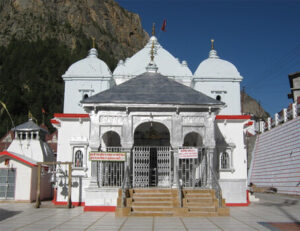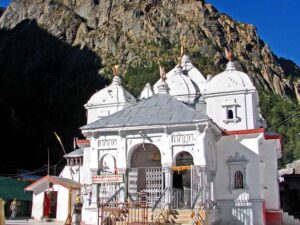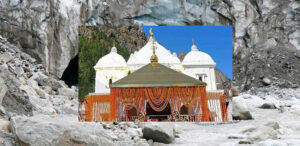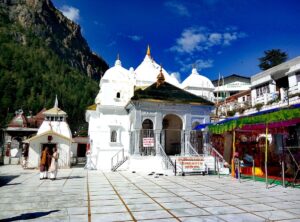Gangotri Temple

Gangotri and Yamunotri are two of the important Char Dham pilgrimage sites in the state of Uttarakhand, India. These sacred destinations are situated in the Garhwal Himalayas and hold immense religious significance for Hindus.

Gangotri:
Location: Gangotri is located in the Uttarkashi district of Uttarakhand.
Geographical Significance: It is situated near the origin of the River Ganges, which is known as the Bhagirathi River at this point. The actual source of the Ganges is the Gangotri Glacier, and Gangotri is considered one of the Char Dham destinations.
Access: The town of Gangotri is accessible by road from Uttarkashi, which is well-connected by road to major cities in Uttarakhand.
Yamunotri:
Location: Yamunotri is situated in the Uttarkashi district of Uttarakhand.
Geographical Significance: It is the origin of the Yamuna River and is one of the Char Dham pilgrimage sites. The Yamunotri temple is dedicated to Goddess Yamuna.
Access: The town of Yamunotri is accessible by road from Uttarkashi, and the Yamunotri trek is a significant part of the pilgrimage, leading to the temple.
Both Gangotri and Yamunotri are part of the Char Dham Yatra, a sacred pilgrimage circuit in the Himalayas, and attract thousands of devotees and tourists every year. These sites are not only spiritually significant but also offer stunning natural beauty amidst the majestic Himalayan landscapes.

Nestled in the lap of the majestic Garhwal Himalayas, the Gangotri Temple stands as a revered Hindu shrine, marking the spiritual source of the sacred Ganges River. Perched at an altitude of approximately 3,100 meters, this sacred pilgrimage site is a significant destination in the Char Dham Yatra. The journey to Gangotri Temple involves traversing through picturesque landscapes, including dense forests, gushing streams, and panoramic mountain vistas, creating a spiritual and awe-inspiring expedition.
Constructed in the 18th century by General Amar Singh Thapa, the temple reflects classic Himalayan architecture with its white structure against the backdrop of rugged peaks. The temple sanctum houses the image of the Goddess Ganga, and pilgrims undertake rituals and prayers amidst the serene atmosphere.
The Gangotri Temple glacier, considered the origin of the Ganges, lies a short trek away from the temple. The Bhagirathi River, initially referred to as Ganga, descends from the glacier, adding to the sanctity of the pilgrimage site. The Ganges, believed to have descended from the locks of Lord Shiva, holds immense spiritual significance for Hindus, and a dip in its icy waters at Gangotri is considered purifying.

The temple is open to devotees only during the summer months, as extreme winter conditions make the region inaccessible. Pilgrims and tourists visiting Gangotri Temple not only seek spiritual solace but also witness the sublime beauty of the Himalayan landscape. The confluence of devotion, natural grandeur, and the sacred river’s origin make Gangotri a destination that transcends the physical and embraces the spiritual essence of the Char Dham Yatra.
The spiritual significance of Gangotri Temple extends beyond its temple and glacier. The trek to Gaumukh, the actual terminus of the Gangotri Glacier and the origin of the Bhagirathi River, is a sacred pilgrimage for those seeking a deeper connection with the holiness of the Ganges. The journey to Gaumukh involves navigating through rocky terrains and witnessing the grandeur of the glacier, an experience that underscores the purity and potency of the river revered as Ganga Mata.

Gangotri Temple also serves as the base for several treks into the pristine Gangotri National Park, home to diverse flora and fauna. The scenic beauty of the region, with the Bhagirathi River flowing vigorously through the valley, captivates the hearts of nature enthusiasts and adventure seekers alike.
The temple complex includes the Pandava Gufa, believed to be the meditation site of the Pandava brothers from the Hindu epic Mahabharata. This adds a historical layer to Gangotri Temple, linking it with ancient mythology and the legends of the sacred river.
Devotees participate in the Ganga Aarti, a captivating ritual performed at the banks of the Bhagirathi River near the temple during the evening. The rhythmic chants, the flickering lamps, and the reverential atmosphere create a divine spectacle, reinforcing the spiritual sanctity of the place.
Gangotri Temple, with its combination of natural beauty, mythological significance, and spiritual aura, remains a destination where pilgrims and travelers alike experience a profound connection with the sacred Ganges, a river that holds not just water but the essence of purity and divinity.
Gangotri Temple is not only a spiritual hub but also a place of cultural and historical importance. The pilgrimage to Gangotri is not just about reaching a geographical location but involves a spiritual journey that symbolizes purification and salvation. Pilgrims often undertake this sacred yatra seeking redemption and the divine blessings associated with the Ganges.
The town of Gangotri Temple itself is small but exudes a tranquil charm. Surrounded by the towering peaks of the Garhwal Himalayas, it offers a serene setting for meditation and reflection. The local markets and streets are infused with a spiritual vibe, where pilgrims and locals share stories of faith and devotion.
The Gangotri Temple, dedicated to Goddess Ganga, stands as a testament to the architectural and cultural heritage of the region. The rituals performed in the temple, along with the chanting of hymns, create an atmosphere charged with spiritual energy. The temple also observes various festivals, with the Gangotri Akhanda Jyoti being a notable celebration where a continuous lamp is lit for several days.
Beyond its religious and cultural significance, Gangotri Temple is a gateway to the stunning Gaumukh Glacier and Tapovan, a high-altitude meadow known for its breathtaking views of the surrounding peaks, including the Shivling Peak. These natural wonders further enrich the pilgrimage experience, offering a chance for introspection and communion with nature.
In summary, Gangotri Temple transcends its role as a pilgrimage site; it is a convergence of spirituality, history, culture, and natural beauty, beckoning pilgrims and travelers to embark on a transformative journey in the heart of the Himalayas.
1. Why is Gangotri temple famous?
- Source of the Ganges River: Gangotri is considered the origin of the sacred Ganges River, which holds immense religious significance in Hinduism. The temple is situated near the point where the Bhagirathi River, one of the main tributaries of the Ganges, emerges from the Gangotri Glacier in the Himalayas.
- Goddess Ganga: The Gangotri Temple is dedicated to Goddess Ganga, personified as the divine river. Devotees believe that worshiping at the temple and taking a dip in the holy waters of the Ganges at Gangotri will cleanse them of their sins and bestow spiritual purification.
- Pilgrimage Destination: Gangotri is one of the Char Dham pilgrimage sites in Hinduism, along with Yamunotri, Kedarnath, and Badrinath. It is visited by thousands of devotees and pilgrims each year, especially during the Char Dham Yatra season, to seek the blessings of Goddess Ganga and embark on a spiritual journey.
- Historical and Cultural Heritage: The Gangotri Temple has a rich historical and cultural heritage, dating back to ancient times. It is believed to have been built by the Gurkha general Amar Singh Thapa in the early 18th century. The temple architecture reflects traditional Himalayan style, with intricate wood carvings and stone masonry.
- Natural Beauty: Situated amidst the breathtaking landscapes of the Garhwal Himalayas, Gangotri offers stunning views of snow-capped peaks, dense forests, and gushing river streams. The natural beauty of the surroundings adds to the spiritual ambiance of the temple and enhances the pilgrimage experience for visitors.

